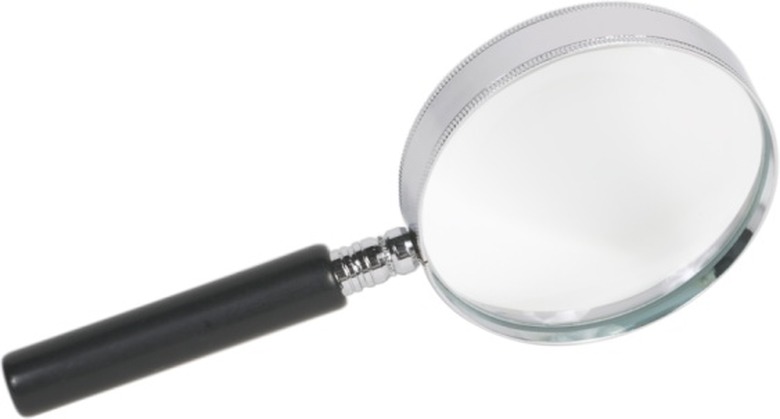Experiments With A Magnifying Glass
A magnifying glass is a convex glass lens. It can enable you to undertake numerous simple experiments. A magnifying glass can increase the size of objects when you look through the glass lens and can concentrate light sources. You can use these experiments for fun and as a great educational tool.
Object View Size
Object View Size
Place a small dark colored object on a sheet of paper. Something like a paperclip works fine. Look at the object, without using the magnifying glass from a distance of about 12 inches. Keep looking at the object and then place the magnifying glass over the object about 1 inch from it. Now slowly move the magnifying glass away from the object and toward your eyes. As you move the glass away from the object, the size of it appears to increase. The farther away you move the glass the larger the object appears, until eventually it goes out of focus.
Light Convergence
Light Convergence
Place a piece of tissue paper in a metal container; colored tissue paper makes it easier. Get a cup of water and then find a sunny place in your backyard; you need the tissue paper to be in direct sunlight. Place the magnifying glass a few inches away from the tissue paper so you see a bright circular spot. Move the glass slowly away from the tissue paper so the spot of light decreases in size, but intensifies in brightness. Keep holding the magnifying glass in the same position once you have the see the brightest spot shining on the paper; you may have to move it forward and backward slightly to get the brightest light. Concentrate on the tissue paper, and you will see smoke coming from where the light is shining. Gently blow on the tissue paper and it catches fire. Move the glass away and use the cup of water to extinguish the flame.
TV Light Pixels
TV Light Pixels
When you look at your TV screen, it appears to be one complete picture, but actually it is made up of thousands of small squares. Turn on your TV and if you have the facility to freeze the picture then do so; it makes the experiment easier. Look at the TV screen from a distance of about 12 inches. Place the magnifying glass about an inch from the screen. Slowly move the glass away from the screen until you can see a selection of colored squares. These individual squares combine to make up the TV picture.
Inverted Objects
Inverted Objects
Place a pen or something similar on a table. Put the magnifying glass a few inches from the pen, and look through the glass from a distance of about 6 inches. Move the magnifying glass away from the pen, but keep the distance between you and the glass the same. First the object appears to enlarge and then it goes out of focus. Keep moving slowly away and you find the pen comes back into focus, but appears to have rotated 180 degrees and is the opposite way around from when you placed it on the table.
Cite This Article
MLA
Benham, Stephen. "Experiments With A Magnifying Glass" sciencing.com, https://www.sciencing.com/experiments-magnifying-glass-8477794/. 24 April 2017.
APA
Benham, Stephen. (2017, April 24). Experiments With A Magnifying Glass. sciencing.com. Retrieved from https://www.sciencing.com/experiments-magnifying-glass-8477794/
Chicago
Benham, Stephen. Experiments With A Magnifying Glass last modified March 24, 2022. https://www.sciencing.com/experiments-magnifying-glass-8477794/
